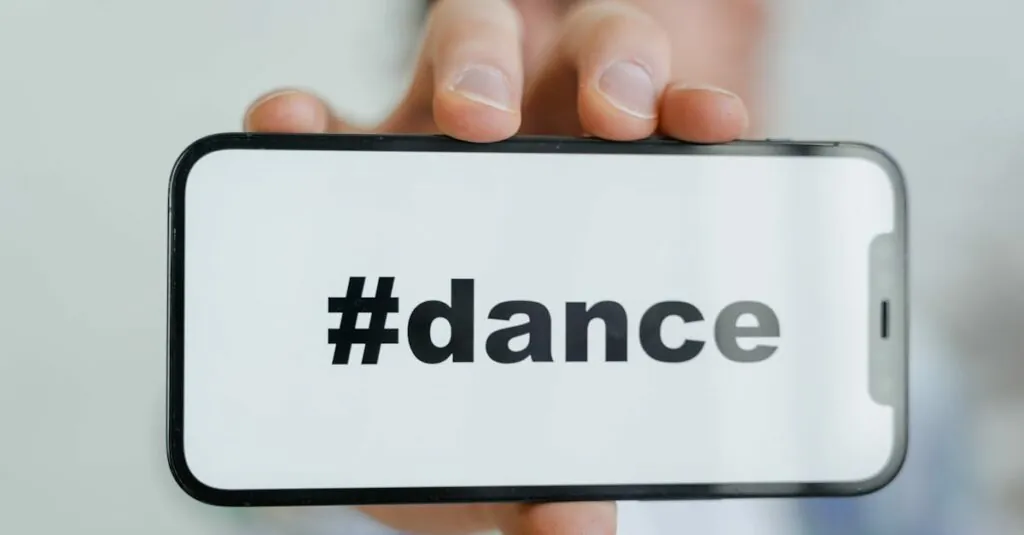Table of Contents
ToggleEver found yourself in the middle of a meeting, a dinner date, or an intense Netflix binge, only to be bombarded by a flurry of text messages? It’s like your phone’s playing a game of “who can distract you more.” But what if there was a way to keep your sanity intact while still being polite? Enter the magical world of auto-replies for iPhone users.
Imagine being able to send a quick “I’ll get back to you later” without lifting a finger. It’s not just a dream; it’s a reality! Whether you’re busy conquering the workday or simply enjoying some well-deserved downtime, auto-reply features can save the day. Let’s dive into how you can set this up and reclaim your peace, one text at a time.
Overview of Auto Replies on iPhone
Auto-replies on iPhone provide users with an efficient way to manage incoming text messages during specific situations. These features allow users to send predefined responses automatically, minimizing distractions while focusing on important tasks. When activated, auto-replies can help maintain communication etiquette without requiring manual input.
Using auto-reply settings in iOS can turn the device into a helpful tool for managing interruptions. Users can customize their auto-replies to reflect personal or professional contexts. For example, users can set a message indicating their unavailability during a meeting or while driving.
The functionality varies based on settings. In the Do Not Disturb mode, iPhones send auto-replies to contacts while the device remains silent. Users can notify callers that they are busy or in transit, fostering understanding from those trying to reach them.
Auto-replies also enhance productivity. By limiting distractions, users can engage more fully in their present activities instead of being diverted by notifications. Quick responses ensure that important conversations remain acknowledged, even when the user cannot respond immediately.
Apple’s Focus modes take auto-replies a step further, allowing users to tailor notifications and automated responses for different circumstances. With these options, users can create personalized experiences, seamlessly balancing work and personal life while maintaining necessary communication.
Overall, auto-replies on the iPhone serve as a valuable tool, promoting efficiency and respectful communication during busy moments.
Setting Up Auto Reply Features
Auto-reply features on iPhone provide a way to manage incoming texts seamlessly. Users can maintain focus while communicating politely.
Using Do Not Disturb While Driving
Using Do Not Disturb While Driving activates automatic replies when the user is in motion. This feature sends a preset message indicating unavailability, promoting safety by discouraging distractions. Contacts receive a notification informing them that their messages have been acknowledged. Users can customize the auto-reply message to convey context, reinforcing awareness about their driving status. Activation occurs via the Settings app, allowing users to toggle the feature on and off easily. When utilized, this option significantly enhances road safety while maintaining communication.
Configuring Focus Modes
Configuring Focus Modes allows users to tailor their auto-replies based on specific situations. Whether at work, home, or during personal time, Focus Modes can be programmed to send appropriate responses. Users can select which contacts receive auto-replies, ensuring important messages still get through. Setting this up involves accessing the Focus feature in the Settings app. Users can create unique profiles, adjusting notification preferences and auto-reply messages accordingly. This level of customization creates a balanced environment, minimizing interruptions while maintaining necessary communication.
Third-Party Apps for Auto Replies
Third-party apps offer additional functionality for auto-replying to text messages on iPhones. These applications provide features that enhance the user experience, making it easier to manage communication.
Popular Auto Reply Apps
Numerous auto-reply apps cater to iPhone users. Options like AutoResponder and TextAloud stand out for their customizable features. Apptivo allows users to set specific timings for auto replies. SMS Auto Reply Text Message is another option that sends automated responses during selected hours. These apps provide diverse ways to handle incoming messages without interrupting daily activities.
Pros and Cons of Using Third-Party Apps
Using third-party apps comes with advantages and disadvantages. Convenience ranks high among the benefits, as these apps often provide more customization than built-in settings. Users can create unique auto-replies tailored to various contexts. On the downside, privacy concerns may arise since some apps require access to the device’s SMS functionality. Additionally, not all apps integrate seamlessly with iOS, potentially leading to compatibility issues. Users must weigh these factors carefully based on their needs and preferences.
Limitations of Auto Reply on iPhone
Auto-reply features on iPhones come with specific limitations that users should know. First, users can only set custom messages for specific circumstances like Do Not Disturb mode. This restricts the flexibility of replies, making it difficult to respond to varying situations with appropriate messages.
Second, responses are not sent to every message received. Only messages from designated contacts trigger auto-replies, potentially leaving out important messages from others. This selective process may lead to misunderstandings, especially in urgent situations.
Third, auto-replies don’t support personalized contexts for every contact. Users must decide which contacts receive specific responses, which can limit communication efficiency. Additionally, users can’t create responses based on the content of incoming messages. The system only allows predefined messages, which may not address unique inquiries adequately.
Fourth, third-party apps may provide enhanced functionalities but can introduce privacy and compatibility issues. Some applications access personal information, generating concerns about data security. Users must consider the trade-off between added features and potential risks.
Fifth, recurring use of auto-replies can diminish their effectiveness over time. Repeated automated messages may come across as insincere or robotic, potentially frustrating contacts who expect timely responses.
Lastly, network connectivity impacts the reliability of auto-reply features. Users must maintain a stable connection to ensure messages are sent without delay. This aspect can pose challenges in areas with limited service, affecting overall effectiveness.
Overall, while auto-reply features on iPhone provide conveniences, understanding their limitations is crucial for effective communication management.
Practical Use Cases for Auto Replies
Auto replies serve various practical functions, enhancing communication during different scenarios. Professionals can maintain focus during meetings by sending predefined messages that indicate unavailability. This quick response helps colleagues understand the user’s current commitments.
Another case involves personal time. When spending time with family or friends, auto replies allow individuals to enjoy the moment while still acknowledging incoming messages. Customization options ensure that responses fit personal or professional contexts.
Safety is a critical factor when driving. Users can activate the Do Not Disturb While Driving mode, automatically informing contacts of their status. This promotes safer driving habits by minimizing distractions from notifications.
In social situations, auto replies can manage expectations. Friends and family will appreciate timely acknowledgment without interrupting conversations. Using tailored messages makes communication smoother without sacrificing personal interactions.
While on vacation, travelers can set an auto reply that informs contacts of their absence. This prevents misunderstandings regarding availability and allows users to disconnect from work-related interruptions.
Different Focus Modes also enable personalized auto replies for various activities. Whether working, exercising, or engaging in hobbies, users can adjust settings to ensure relevant contacts receive appropriate messages.
Using third-party apps adds another layer of customization for specific situations. Options like AutoResponder and Apptivo provide unique features that may cater to individual preferences, improving the overall experience of managing auto replies.
Notably, understanding limitations proves essential for effectively utilizing auto replies. Custom messages reach designated contacts only, which may not cover all critical communications. Recognizing these constraints helps users maximize the benefits of this feature.
Auto-reply features on iPhones offer a practical solution for managing text message interruptions during important moments. By customizing responses through Do Not Disturb and Focus modes, users can maintain communication etiquette while focusing on their current activities.
While these features enhance productivity and safety, it’s essential to recognize their limitations. Auto-replies may not reach all contacts and can lack personalization based on message content.
Exploring third-party apps can provide additional functionality, but users must consider privacy and compatibility issues. Overall, embracing auto-replies can lead to a more balanced approach to communication, allowing individuals to enjoy their time without constant distractions.







